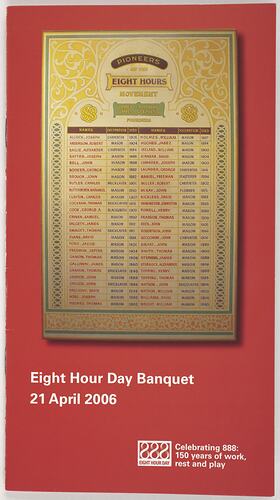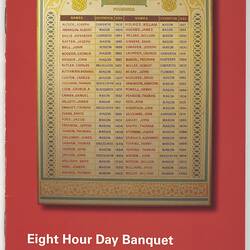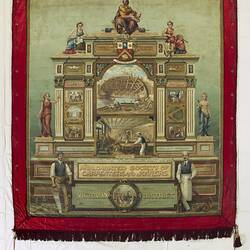Summary
Program for the Eight Hour Day Banquet, held at Melbourne Museum on 21 April 2006, to mark the 150th anniversary of the Eight Hour Day in Victoria.
The banquet was part of a rich program celebrating the 150th anniversary of the Eight Hour Day movement. Planning for the celebrations commenced in mid-2003. The main program partners were Australian Centre for the Moving Image, Australian Society for the Study of Labor History, City of Melbourne, Heritage Victoria, Melbourne Workers Theatre, Museum Victoria, RMIT University, State Library of Victoria, University of Melbourne and Victorian Trades Hall Council. The final line-up for the program had 11 exhibitions, 3 theatrical shows, 2 conferences, a public forum, public lecture, 2 community events and a banquet.
Description of Content
Program for the Eight Hour Day Banquet, held at Melbourne Museum 21 April 2006, to mark the 150th anniversary of the Eight Hour Day in Victoria.
Physical Description
12 page booklet, printed full colour.
Significance
2006 marked the 150th anniversary of the Eight Hour Day in Victoria. Action taken by stonemasons on 21 April 1856 led to the establishment of the Eight Hour Day, with the government agreeing that workers employed on public works should enjoy an eight hour day with no loss of pay. It was a world first and became emblematic of the rights of labour.
Represented by the slogan 'eight hours labour, eight hours rest, eight hours recreation' and the intertwined numbers '888', the Eight Hour Day became a symbol of the rights of workers to organise to achieve their rights not only as workers, but as citizens in a democratic society.
Planning for the celebrations to mark the 150th anniversary commenced in mid 2003. The main program partners were Australian Centre for the Moving Image, Australian Society for the Study of Labor History, City of Melbourne, Heritage Victoria, Melbourne Workers Theatre, Museum Victoria, RMIT University, State Library of Victoria, University of Melbourne and Victorian Trades Hall Council. The final line-up for the program had 11 exhibitions, 3 theatrical shows, 2 conferences, a public forum, public lecture, 2 community events and a banquet.
More Information
-
Collecting Areas
-
Acquisition Information
Collected from Dr Richard Gillespie - Museum Victoria, 05 Dec 2006
-
Organiser of Event
-
Issued By
Museum Victoria, Melbourne, Greater Melbourne, Victoria, Australia, 2006
-
Place & Date of Event
Museum Victoria, Rathdowne Street, Carlton, Greater Melbourne, Victoria, Australia, Apr 2006
-
Inscriptions
Inscriptions: 'Eight Hour Day Banquet/21 April 2006'
-
Classification
-
Category
-
Discipline
-
Type of item
-
Overall Dimensions
100 mm (Length), 180 mm (Width)
-
References
Celebrate 888: Report on the Celebration of the 150th Anniversary of the Eight Hour Day, 2006, Museum Victoria, 2006
-
Keywords
8 Hours Day Movement, Trade Unions, 8 Hours Day Celebrations, Working Life, Workers Rights, Banquets



